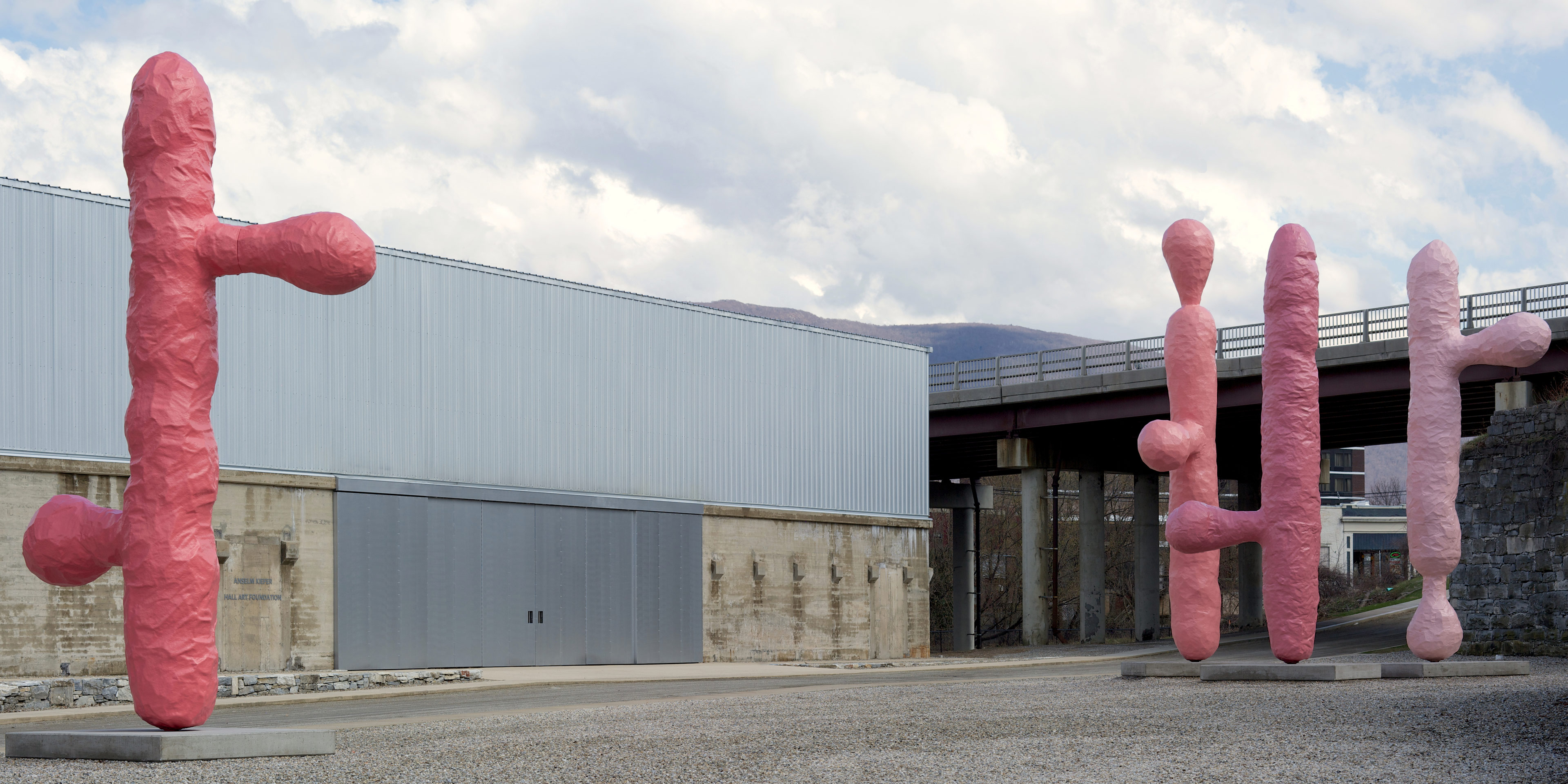 Exhibition
Exhibition- Closed for the season, on view spring 2024
- MASS MoCA
Franz West’s Les Pommes d’Adam—a monumental outdoor sculptural ensemble on extended loan from the Hall Art Foundation—appears at MASS MoCA, in its first presentation in the United States and its second-ever showing. The sculpture was previously exhibited in 2007, when it was installed at the Place Vendôme in Paris next to Napoléon Bonaparte’s Vendôme Column.
When Franz West’s Les Pommes d’Adam was first displayed in Paris’ Place Vendôme in 2007, the exhibition curators noted that the sculpture took its name and inspiration from the Adam’s apple, pointing to the distinctive anatomical profile of a man’s throat. The public, however, interpreted the gathering of bubblegum-pink sculptures in a slightly more provocative way, locating the reference lower on the male torso.
West would have reveled in the confusion, having once said, “It doesn’t matter what art looks like, but how it is used.” The use of art, and its interpretation by individuals, was always of interest to West. Among his earliest works are the Paßstücke, or Adaptives, a series of small, portable plaster objects, a selection of which was exhibited at MASS MoCA in 2002. Adaptives were made to be picked up and manipulated by the viewer, their meaning changing with use. Some might be utilized as bookends or flower vases, while others may be displayed on sculptural plinths.
Les Pommes d’Adam, like much of West’s work, is infused with humor and a particular delight in visual and linguistic puns. It pokes, provokes, and makes us reconsider our physical and psychological relationship to art. The sculpture’s evocation of the human body recalls the work of the Actionists, a group of artists prominent in Vienna while he was a student at the Academy of Applied Arts. Like the American Fluxus group, the Actionists sought to create art outside the usual gallery and market structure, often as free-form events or happenings that yielded abstract works of art and ritualistic, body-oriented performances.
Les Pommes d’Adam is rough-hewn and made of basic materials: metal, epoxy, paint, and concrete. The 4 pink biomorphic totems, each standing at approximately 25 feet, are at once crude in shape, yet highly finished. In its Paris showing, Les Pommes d’Adam was installed in close proximity to the Vendôme Column, on top of which stands a statue of Napoléon Bonaparte in Roman garb. West’s presentation of Les Pommes d’Adam at the Place Vendôme engaged and perhaps parodied the Napoleonic Column, prompting viewers to reinvestigate it and its role in the history of Paris and France. The idiomatic expression, “Napoleon complex,” for example, takes on new meaning in light of the apocryphal tale of the etymology of the term “Adam’s apple.” According to the biblical passage, the Tree of Knowledge in the Garden of Eden was an apple tree. When Eve gave Adam a piece of the tree’s forbidden fruit and he ate it, a fragment became lodged in his throat. The Adam’s apple thus serves as a permanent reminder of the folly of desiring that which one should not have, or know. Likewise, with its monumental, if not pretentious, scale, Les Pommes d’Adam may offer a playful warning about the perils of unbridled ambition.
Further Reading
Faye Hirsch, “Opus Posthumous” in Art In America (June 2013)
Roxana Marcoci, Interview with Franz West in Comic Abstraction: Image-Breaking, Image-Making (MoMA, 2007, click photo of Franz West, Lisa de Cohen with Adaptive, Vienna, c. 1983 to read)
The Hall Art Foundation makes available works of postwar and contemporary art from its collection and from the collection of Andrew and Christine Hall for the enjoyment and education of the public. In addition to the dedicated gallery space at MASS MoCA, the Hall Art Foundation operates a contemporary art space in Reading, Vermont. Read more here about the West exhibition.


